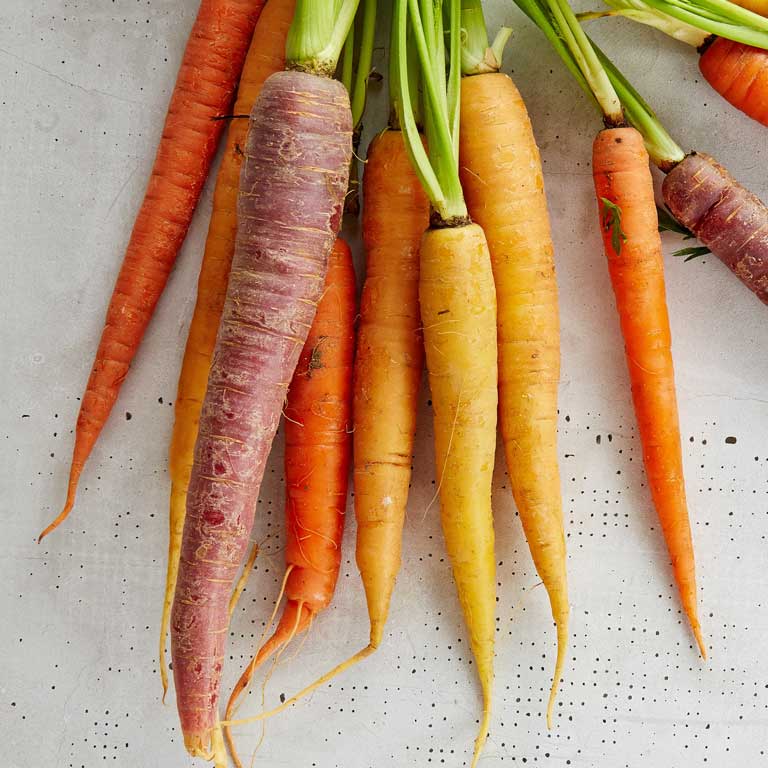
Beta-carotenes: your great ally this summer
You may have heard the word “beta-carotene”, and it will be associated with the carrot. If yes, you're on the right track because in these plants, from which we consume their orange root, is the secret of the healthy qualities that beta-carotene has in your body, and much more in summer.
In this post we explain you what are beta-carotenes, the activity carried out in your body, their qualities, their close relationship with vitamin A, and also in which foods you can find them and the recommended daily allowance.
What are beta-carotenes? These are the activities carried out in our body
Beta-carotenes are pigments with high antioxidant capacity that are precursors of vitamin A. As part of the carotenoid family they are liposoluble compounds (they can dissolve in fat), and their pigments cause some vegetables and fruits to have their characteristic red, orange and yellow colours, although they are also present in some green vegetables.
There is a type of carotenoid with pro-vitamin A activity: this means that, once they are in the body, they are transformed to become this much needed vitamin. This is why beta-carotenes are said to be precursors, or inducers, of vitamin A. Among the different branches of the carotenoid family, beta-carotenes have a great advantage: they are present in many foods that we consume more, especially in hot weather.
What are the beta-carotenes qualities?
Why is it important to make sure we eat foods with beta-carotene? Because, in that role of facilitating vitamin A levels, they help us to benefit from it.
If you are concerned about fighting premature aging, beta-carotenes are great allies, because they are key, for example, to fight free radicals. But they have other advantages of taking into consideration.

Beta-carotene’s qualities in your body
They help promote healthy skin. Beta-carotenes help change sun sensitivity in photosensitive people. The American Journal of Clinical Nutrition notes in a study that their antioxidant properties help reduce skin damage and improve skin appearance, giving it a more healthy aspect.
They enhance a natural tan. Be careful with this effect. As fat-soluble pigments, beta-carotene tints the skin and makes it look more tanned, but it does not protect against the effects of the sun. Therefore, sunscreen should always be used when exposed to the sun continuously, and beta-carotene should be used after sunbathing.
They are good for your eyesight. When we were children, we were told that carrots were good for our eyesight, we were not on the wrong track.
Beta-carotenes, taken in high doses, and combined with vitamins C and E, zinc and copper, can reduce the risk of macular degeneration, a disorder that causes a los of central vision in older people and makes reading difficult, for example.
They promote cognitive function. Long-term consumption of this component may be related to the good state of our cognitive function.
They facilitate the proper functioning of the immune system. Beta-carotene helps the immune function by promoting good levels of white blood cells.
The relationship between beta-carotene and Vitamin A
Beta-carotene and vitamin A need each other. The Spanish Society of Dietetics and Food Sciences(SEDCA) explains that vitamin A is fat-soluble. The active form of this vitamin, retinol, is only found in foods of animal origin. In contrast, in fruits and vegetables there is provitamin A: carotenoids.
After eating fruit and vegetables, our body converts the molecules into the active form of vitamin A, just as effectively as if we were eating meat. As we have seen, beta-carotenes are the most common carotenoids.
Furthermore, SEDCA also highlights that some nutrients are destroyed by high temperatures, however beta-carotenes are absorbed and used better.
Therefore, you can not only eat raw fruits and vegetables in salads. If you don't want to deprive yourself of the pleasure of grilling, or if you cook your vegetables roasted or steamed for a few minutes, you won't lose any nutrients. As beta-carotene is fat-soluble, it is recommended to consume it with a fat to make it better absorbed.
Foods with beta-carotene
Foods richest in beta-carotene are red, orange and yellow. Carrot is the most popular. If you are linguistically curious, the relationship between beta-carotene and carrot goes beyond its properties: the word beta-carotene comes from the Latin name of this plant, Daucus carota.
In reference to the food and its shade, you should not be obsessed with the color code, because these antioxidants are also present in some foods green discoloration, by chlorophyll. These are some of the fruits and vegetables where you can get this natural antioxidant.
Beta-carotene in red, orange and yellow foods:
- Carrots
- Pumpkin
- Red and yellow peppers
- Tomatoes
- Corn
- Sweet potato
- Paprika
- Oranges and tangerines
- Apricots, peaches, medlars
- Plums
- Mango, papaya, persimmon
- Apples
- Strawberries
- Cantaloupe
Beta-carotene in green foods:
- Spinach, chard, and dark leafy vegetables
- Endive, cabbage, kale and Brussels sprouts
- Broccoli
- Rocket, watercress
- Green pepper
- Cucumber
- Green asparagus and green beans
- Aromatic herbs such as parsley and coriander.
Recommended daily amount of beta-carotene
It is recommended to consume 6 to 15 milligrams (mg) of beta-carotene per day. This is equivalent to 10,000-25,000 units of vitamin A activity, about 70% of the daily requirement for women and 55% for men.
For children, these amounts are reduced to between 3 and 6 mg of beta-carotene per day (5,000-10,000 units of vitamin A activity), which would be between 50% and 83% of their daily requirements.
According to a study on the nutritional characteristics of the main foods in the Spanish diet by the Spanish Nutrition Foundation (FEN), "an average-sized carrot covers 89% of the daily vitamin A needs for men between 20 and 39 years of age and 112% for women of the same age". This study also highlights the presence and beneficial action of carotenoids with proto-vitamin A activity, specifically, beta-carotene (6,628 μg/100 g of edible portion).





